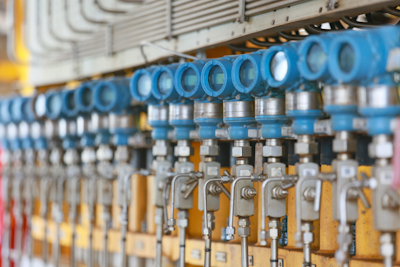Impact of Shock and Vibration on Pressure Transducers

Figure 1: Shock and vibration in pressure transducers can compromise their accuracy and longevity
Pressure transducers are frequently subjected to harsh operational environments, making them susceptible to shock and vibration. Understanding how these parameters affect pressure transducers is crucial for maintaining their accuracy and longevity. This article explores the mechanisms behind these impacts and discusses strategies to mitigate their effects, ensuring optimal performance and durability.
Table of contents
- Distinguishing shock and vibration in pressure transducers
- Problems caused by shock and vibration in transducers
- Effective ways to mitigate shock and vibration issues
- FAQs
View our online selection of pressure transducers!
Distinguishing shock and vibration in pressure transducers
Shock and vibration are distinct phenomena, each posing unique challenges to pressure transducers.
- Shock: Shock refers to a sudden, momentary impact that transfers energy to the system in a very short period. For a pressure transducer, this energy travels through the housing of the device. This can occur due to rough handling, transportation mishaps, or sudden mechanical impacts from equipment like conveyor systems, forklifts, and industrial trucks. While a single shock event might not immediately damage a transducer, repeated low-level shocks can lead to cumulative damage and eventual failure. Shock is often a precursor to vibration within the system.
- Vibration: Vibration is characterized by mechanical oscillations that can be periodic or random. For example, an engine in operation generates continuous vibrations, which can adversely affect a pressure transducer if it is mounted too close. Unlike shock, vibration is a sustained force that can lead to gradual wear and tear on the transducer components.
Problems caused by shock and vibration in transducers
Pressure transducers exposed to shock and vibration can experience several issues.
- Broken circuit boards: Repeated mechanical stress can cause circuit boards within the transducer to crack or break, leading to malfunction.
- Mechanical hardening: Continuous exposure to vibration can cause materials to harden and become brittle, increasing the likelihood of failure.
- Unwanted noise: Mechanical vibrations can introduce noise into the signal, leading to inaccurate readings.
- Connector separation: Vibration can cause connectors to loosen or separate, disrupting the electrical connections necessary for accurate signal transmission.
- Broken enclosures: The physical casing of the transducer can crack or break under repeated shock or vibration, exposing internal components to environmental damage.
- Damaged signals: Both shock and vibration can distort the electrical signals generated by the transducer, leading to erroneous data.
Effective ways to mitigate shock and vibration issues
To ensure the reliable performance of pressure transducers in environments prone to shock and vibration, several strategies can be employed:
-
Installation and assembly:
- Position the transducer as far away as possible from sources of shock and vibration to reduce impact. Use shock and vibration isolators (devices to absorb and dampen shock and vibration) to further protect the transducers.
- Engineers should design the installation process to require only a few specific tools to ensure the correct tools are used. For example, use a standard open-end wrench instead of channel locks to prevent damage to the transducer's housing.
- If the assembly is heavier than the approved weight limit, work procedures should specify that two people are required to lift it. This precaution helps prevent one person from dropping and damaging the assembly.
- Electrical disturbance elimination: External electrical disturbances from power lines, computers, and cell phones can interfere with the transducer's signal conversion process. Implementing RF design constructions such as shielding, filtering, and suppression can mitigate these effects.
- Overpressure control: Setting appropriate pressure limits based on the system's dynamics can prevent overpressure, which can cause faulty readings or permanent damage to the transducer's diaphragm.
- Temperature regulation: Maintaining the transducer within its specified temperature range is crucial, as temperature fluctuations can lead to inaccurate performance.
Other practical measures
When selecting a pressure transducer for environments with high mechanical stress, consider options like a high vibration pressure transducer or a no shock pressure transducer. These specialized devices are designed to withstand the rigors of continuous operation in harsh conditions. For applications involving specific types of mechanical oscillations, a vibrating cylinder pressure transducer might be suitable. Additionally, in scenarios where sudden impacts are a concern, a shock wave pressure transducer can provide the necessary durability and accuracy.
FAQs
Does vibration affect pressure measurement?
Yes, vibration can introduce noise and distort the signal, leading to inaccurate pressure readings.
What are the limitations of pressure transducers?
Limitations include sensitivity to shock, vibration, temperature fluctuations, and overpressure, which can affect accuracy and longevity.
What damage can vibration cause in a pressure transducer?
Vibration can cause broken circuit boards, mechanical hardening, unwanted noise, connector separation, and damaged enclosures.





